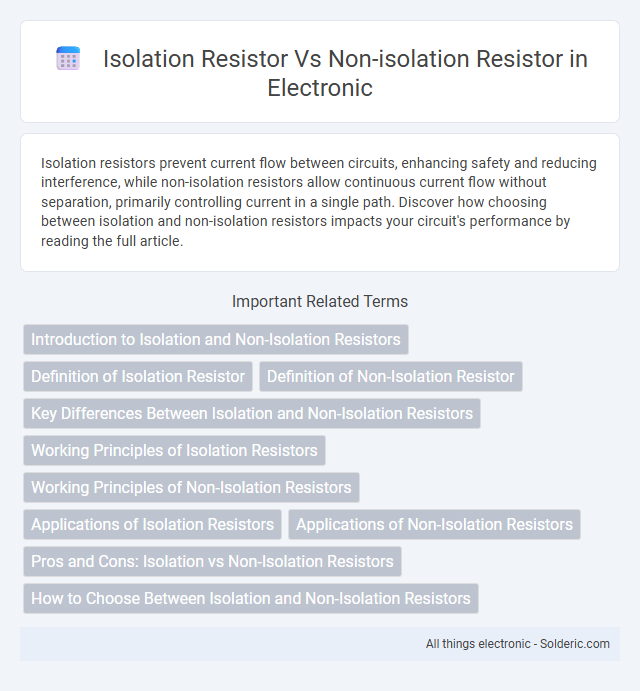Isolation resistors prevent current flow between circuits, enhancing safety and reducing interference, while non-isolation resistors allow continuous current flow without separation, primarily controlling current in a single path. Discover how choosing between isolation and non-isolation resistors impacts your circuit's performance by reading the full article.
Comparison Table
| Feature | Isolation Resistor | Non-Isolation Resistor |
|---|---|---|
| Purpose | Prevents current flow between circuits for safety and signal integrity | Allows direct current flow without separation |
| Electrical Isolation | Provides electrical isolation between components or circuits | No electrical isolation; connections are direct |
| Use Case | Used in sensitive electronics, signal conditioning, and noise reduction | General-purpose applications without isolation needs |
| Impact on Signal | Minimizes interference and crosstalk | Possible noise or interference transmission |
| Cost | Higher due to specialized function | Lower cost, simple implementation |
| Complexity | Requires careful design for effective isolation | Simple circuit integration |
Introduction to Isolation and Non-Isolation Resistors
Isolation resistors are designed to provide electrical separation between circuits, preventing current leakage and enhancing safety in sensitive electronic systems. Non-isolation resistors, on the other hand, connect circuits without providing this separation, allowing direct current flow and simpler signal transmission. Your choice between isolation and non-isolation resistors affects circuit performance, protection, and noise reduction.
Definition of Isolation Resistor
An isolation resistor is a specialized resistor designed to separate different sections of an electrical circuit, preventing direct electrical contact and minimizing noise interference or fault propagation. Unlike non-isolation resistors, which allow current to pass freely within a single circuit segment, isolation resistors ensure signal integrity by limiting undesired current flow between isolated components or systems. This functionality is crucial in applications such as medical devices, communication systems, and power electronics, where maintaining electrical isolation enhances safety and performance.
Definition of Non-Isolation Resistor
A non-isolation resistor directly connects circuits without providing electrical isolation, allowing continuous current flow for signal or power transfer. Unlike isolation resistors, it lacks features to prevent voltage spikes or isolate faults between different components. Non-isolation resistors are commonly used in applications where electrical separation is unnecessary, prioritizing simple conduction and minimal impedance.
Key Differences Between Isolation and Non-Isolation Resistors
Isolation resistors provide electrical separation between circuit sections to prevent current leakage and improve safety, while non-isolation resistors do not offer this separation and are primarily used for current limiting or voltage division. Isolation resistors often feature higher resistance values and are designed to withstand voltage spikes, ensuring minimal interference between connected components. Non-isolation resistors focus on precise resistance with tighter tolerance for accurate signal conditioning and load control in the circuit.
Working Principles of Isolation Resistors
Isolation resistors function by providing a deliberate resistance path that prevents direct electrical connection between circuits, effectively minimizing fault propagation and improving safety. These resistors maintain signal integrity by reducing noise and interference, which is crucial in sensitive electronic applications. Your system benefits from enhanced protection and stable operation through the controlled current flow enabled by isolation resistors compared to non-isolation resistors that lack this designed separation capability.
Working Principles of Non-Isolation Resistors
Non-isolation resistors operate by allowing direct electrical connection between circuits, providing a continuous conductive path that enables current flow without interrupting circuit integrity. This direct connection facilitates voltage division, current limiting, or signal conditioning but lacks galvanic isolation, making them unsuitable for applications requiring noise reduction or safety separation. Their working principle centers on dissipating electrical energy through resistance while maintaining seamless electrical continuity.
Applications of Isolation Resistors
Isolation resistors are essential in applications requiring electrical separation between circuits to prevent interference, enhance safety, and protect sensitive components in medical devices and telecommunications equipment. They are commonly used in signal conditioning, analog-to-digital converter inputs, and industrial automation systems to maintain signal integrity and reduce noise. Your designs benefit from improved reliability and compliance with safety standards when incorporating isolation resistors in critical circuit paths.
Applications of Non-Isolation Resistors
Non-isolation resistors are primarily used in applications where direct electrical connection between circuits is required, such as in signal conditioning and voltage division within electronic devices. They enable efficient current flow and accurate voltage reference in low-voltage power supplies, audio equipment, and measurement instruments. These resistors are ideal for circuits that do not need galvanic isolation but require precise resistance values for proper functioning.
Pros and Cons: Isolation vs Non-Isolation Resistors
Isolation resistors provide enhanced safety by preventing electrical shock and minimizing interference between circuits, making them ideal for sensitive or high-voltage applications. Non-isolation resistors offer simpler designs with lower cost and reduced circuit complexity but may expose your system to potential noise and safety risks due to lack of electrical separation. Choosing between isolation and non-isolation resistors depends on the specific requirements for protection, performance, and budget in your electronic design.
How to Choose Between Isolation and Non-Isolation Resistors
Choosing between isolation and non-isolation resistors depends on the specific safety and signal integrity requirements of your circuit. Isolation resistors prevent current leakage and protect sensitive components by electrically separating sections, while non-isolation resistors prioritize direct signal transmission with minimal impedance. Evaluate your design's need for noise reduction, protection from transient voltages, and compliance with regulatory standards to determine the optimal resistor type for your application.
isolation resistor vs non-isolation resistor Infographic

 solderic.com
solderic.com